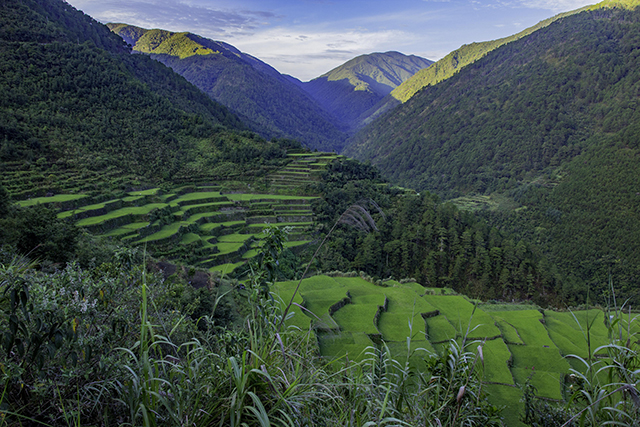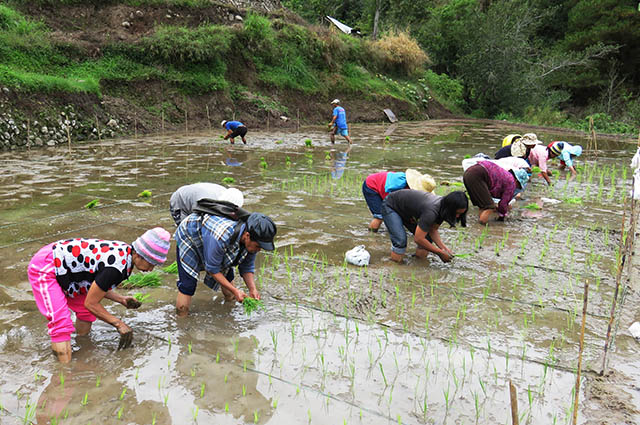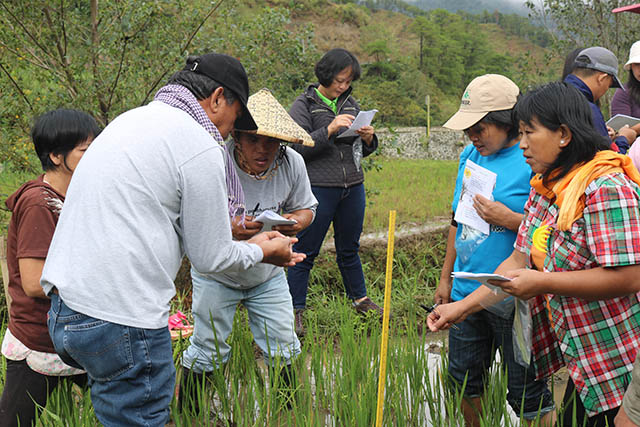 Handed down through generations, heirloom rices are special breeds of rice. They exhibit exceptional nutritional value, flavor, aroma, color, and cooking quality. While the demand for these varieties is high both in local and international markets, its production is low.
Handed down through generations, heirloom rices are special breeds of rice. They exhibit exceptional nutritional value, flavor, aroma, color, and cooking quality. While the demand for these varieties is high both in local and international markets, its production is low.
Clara Saga-oc Aboli, a rice farmer from Kalinga, Apayao, admitted that heirloom rice despite its promising qualities was not a high yielder. She could only harvest 6 chayan or 360 bundles with each chayan weighing around 50 kg on her 3 kil-ling or around 1, 200 square meters of farmland. Every threshing, she would have to pay P80 per bundle, excluding meals and snacks.
This changed, however, when the Heirloom Rice Project was introduced to their community. The Heirloom Rice Project is a collaborative effort of PhilRice, IRRI, DA-CAR, LGUs, Self-help groups (SHG), and RICE Inc. under the DA’s Food Staples Sufficiency Program (FSSP).
Ruben Miranda, project co-lead, said the project aimed to enhance the productivity of and enrich the legacy of heirloom rice through empowered indigenous communities.
Heirloom rice varieties are grown in certain regions of Mindanao, such as Banasilan, Alamada, and the Arakan Valley in North Cotabato. They are also widely grown in provinces and municipalities of Cordillera Administrative Region (CAR), where Clara and her colleagues farm.
“Through the course of the project implementation, interrelated activities were conducted, such as characterization of existing heirloom varieties, local capacity enhancement and enterprise building, value adding and market linkages creation, documentation of best management practices, and improving the resistance and tolerance to disease and stresses of selected heirloom varieties,” Miranda said.
With the project, “our group was given a panicle thresher. It didn’t just make the threshing faster, it also enabled me to save on labor cost as I am now doing the threshing myself,” Clara narrated.
According to Miranda, the distribution of farm machines is just one among the many interventions of the project. The distribution eased the farm labors, and it evaluated the usefulness of the machines on local farming conditions.
“We were able to organize and strengthen existing 12 self-help groups (SHG) of men and women farmers across the CAR. They were given eight mini threshers, nine moisture grain meters, 12 micro tillers, 13 weighing scales, 14 panicle threshers, 26 knapsack sprayers, and 420 super grain bags,” Miranda said.
He added that the premium produce of these SHGs were also tapped and linked to market chains locally and internationally.
In a span of 3 years, the project was able to establish 14 two-cropping-season farmer field schools (FFS) with 290 farmer graduates, and 12 demonstration and seed production farms for farmer-preferred varieties: Chong-ak and Ulikan in Kalinga, Minaangan and Tinawon in Ifugao, Chorchor-os, Ominio, and Balatinaw in Mt. Province, Lasbakan and Balatinaw in Benguet, and Denorado and Azucena in Cotabato and Sultan Kudarat. According to Miranda, each farm yielded an average of 2-3 t/ha.
A total of 124 varieties were collected in seven municipalities of CAR, two municipalities from North Cotabato, and one municipality in Sultan Kudarat, with 10-15 varieties grown in roughly 1000 square meter plots in each SHG barangay. These varieties were used for characterization, purification, seed production, and as learning fields for the farmers. Furthermore, 13 varieties were demonstrated, characterized, and purified in Benguet; 16 in Mt. Province; 19 in Kalinga; 22 in Ifugao; 38 in North Cotabato; and 16 in Sultan Kudarat.
 Clara and her fellow heirloom farmers also attended season-long farmer field schools (FFS). During the FFS, they were taught how to make their own organic foliar fertilizers through the use of readily-available resources such as fruit and plant juices and snails. The 13 FFS were conducted in 6 provinces in collaboration with DA-RFOs, SCUs, and LGUs. From these FFS, a Farmer Field School Curriculum Guide was developed.
Clara and her fellow heirloom farmers also attended season-long farmer field schools (FFS). During the FFS, they were taught how to make their own organic foliar fertilizers through the use of readily-available resources such as fruit and plant juices and snails. The 13 FFS were conducted in 6 provinces in collaboration with DA-RFOs, SCUs, and LGUs. From these FFS, a Farmer Field School Curriculum Guide was developed.
Documentation of best and new farming practices from seed selection to post-harvest activities was done through farmer interviews (focus group discussion and participatory needs and opportunities assessment), participatory discussion during FFS, and study results from the established FFS learning field trials and Participatory Heirloom Rice Characterization Plot (PHRCP). According to Miranda, the data from the documentation will be used to develop a PalayCheck (a crop management system) for highland organic rice production integrating their best farming practices.
“The project didn’t just make our farming easier, but also increased our income and the time spent for our family. The machines made tasks from land preparation to harvesting easier, faster, and cheaper, and the market linkages converted our produce from mere harvest to more income,” Clara said.
“The heirloom rice is special. It binds its farmers and the communities in the most interesting way. Through the Heirloom Rice Project, we were able to preserve and improve the varieties. Accordingly, the special kinship that tightly connects the people of highlands was also preserved and valued,” Miranda concluded.





